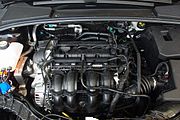
The Ford Ka is a small car manufactured by Ford Motor Company from 1996 to 2016 as a city car and from 2014 to 2021 as a subcompact car. It entered its second generation in 2008, produced by Fiat in Tychy, Poland. A third generation was introduced in 2016.
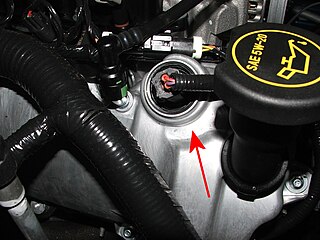
Variable camshaft timing (VCT) is an automobile variable valve timing technology developed by Ford. It allows for more optimum engine performance, reduced emissions, and increased fuel efficiency compared to engines with fixed camshafts. It uses electronically controlled hydraulic valves that direct high pressure engine oil into the camshaft phaser cavity. These oil control solenoids are bolted into the cylinder heads towards the front of the engine near the camshaft phasers. The powertrain control module (PCM) transmits a signal to the solenoids to move a valve spool that regulates the flow of oil to the phaser cavity. The phaser cavity changes the valve timing by rotating the camshaft slightly from its initial orientation, which results in the camshaft timing being advanced. The PCM adjusts the camshaft timing depending on factors such as engine load and RPM.

The Jaguar AJ-8 is a compact DOHC V8 piston engine used in many Jaguar vehicles. It was the fourth new engine type in the history of the company. It was an in house design with work beginning before Ford's purchase of the company. In 1997 it replaced both designs previously available on Jaguar cars: the straight-6 Jaguar AJ6 engine, and the Jaguar V12 engine. It remained the only engine type available on Jaguar until 1999 with the launch of the S-Type, when the Jaguar AJ-V6 engine was added to the list. The AJ-V8 is available in displacements ranging from 3.2L to 5.0L, and a supercharged version is also produced. Ford Motor Company also used this engine in other cars, including the Lincoln LS and the 2002–2005 Ford Thunderbird, as well as in several Land Rovers, and the Aston Martin V8 Vantage.
The Jaguar AJ-V6 engine is a piston engine based on the Ford Duratec V6 engine. The Duratec V6 was originally a Porsche design, purchased by the Ford Motor Company with Cosworth finishing the engineering to suit Ford's needs. One notable addition is the use of variable valve timing, a feature also shared with Mazda's version of the engine. It is available in 2.1 L (2,099 cc), 2.5 L (2,495 cc) and 3.0 L (2,967 cc) displacements.

The Ford EcoSport is a subcompact crossover SUV (B-segment) manufactured by Ford between 2003 and 2023.

The Ford Puma is a small car that was produced by Ford Europe from September 1997 to July 2002. The Puma is a three-door coupé that is based on the Mark IV Ford Fiesta and was built at Ford's Niehl plant in Cologne, Germany. The Puma follows common design cues with other Ford cars at the time, and is in the New Edge family of vehicles.

The Ford Galaxy is a seven-seater car produced by Ford of Europe from June 1995 to April 2023. Considered in the motor industry to be a large multi-purpose vehicle (MPV), it was the first Ford-brand MPV produced and marketed outside of North America, the model line is currently in its third generation. Sharing its platform architecture with the Ford Mondeo, the Galaxy was developed alongside the Ford S-Max; the model line is slotted between the Connect and Custom variants of the Ford Tourneo/Transit model family.
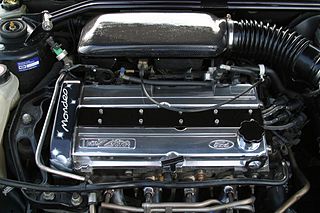
Developed in the late 1980s by the Ford Motor Company, the Ford Zeta engine was a straight-4, double overhead cam internal combustion engine with which Ford had intended to replace the analogous Pinto and CVH models.

The Cyclone engine, also branded Duratec, is Ford Motor Company's latest DOHC family of gasoline V6 engines introduced in 2006. The Cyclone succeeds Ford's previous V6 engine families, including the Canadian built Ford Essex engine introduced in 1981, the Ford Vulcan engine introduced in 1985, the original Duratec V6 introduced in 1993, and the Ford Cologne V6 engine, whose design dates back to 1962. The first version of the Cyclone engine, a 3.5 L V6, appeared in the 2007 Ford Edge and the Lincoln-badged luxury variant, the Lincoln MKX, as well as the Lincoln MKZ. Mazda badges its versions of the Cyclone MZI as it did with its versions of the Duratec V6.

The Ford Duratec V6, is an aluminum DOHC V6 engine with a 60° bank angle introduced in 1993 with the Ford Mondeo. The primary engineering input came from Porsche, who was developing a similar V6 before selling the engineering to Ford, and Cosworth, who helped with cylinder head manufacturing. The Jaguar AJ-V6 engine is similar but adds variable valve timing.

EcoBoost is a series of turbocharged, direct-injection gasoline engines produced by Ford and originally co-developed by FEV Inc.. EcoBoost engines are designed to deliver power and torque consistent with those of larger-displacement naturally aspirated engines, while achieving up to 20% better fuel efficiency and 15% fewer greenhouse emissions, according to Ford. The manufacturer sees the EcoBoost technology as less costly and more versatile than further developing or expanding the use of hybrid and diesel engine technologies. EcoBoost engines are broadly available across the Ford vehicle lineup.

The Mazda L-series is a mid-sized inline 4-cylinder gasoline piston engine designed by Mazda as part of their MZR family, ranging in displacement from 1.8 to 2.5 liters. Introduced in 2001, it is the evolution of the cast-iron block F-engine. It was co-developed with Ford, who owned a controlling stake in Mazda at the time. Ford uses it as their 1.8 L to 2.5 L Duratec world engine and holds a license to develop engines based on the L-series in perpetuity.

The Ford Focus (third generation), also known as the Focus Mk III, (Code name: C346) debuted at the 2010 North American International Auto Show as a 2012 model. The cars shown were a 4-door sedan and 5-door hatchback, also debuting a new 2.0-litre direct injection I4 engine. A 5-door estate (wagon) was previewed at the Geneva Motor Show a month later.
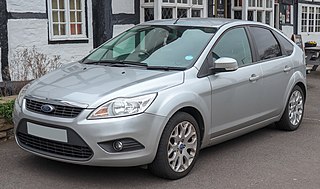
The Ford Focus Mk 2 is the second generation of Ford Focus, a range of small family cars produced by Ford Motor Company from 2005 to 2010. It was launched at the Paris Motor Show on September 25, 2004, as a three and five-door hatchback and an estate, although the new car was previewed, in 4-door saloon form, as the 'Focus Concept' developed by Ford Europe at the Beijing Motor Show in mid-2005.

Ford Motor Company used the Zetec name on a variety of inline 4-cylinder automobile engines. It was coined to replace "Zeta" on a range of 1.6 L to 2.0 L multi-valve engines introduced in 1991 because Ford was threatened with legal action by Lancia who owned the Zeta trademark. The company used the name widely in European advertising and later introduced it to the North American market with the Contour.

The Ford Mondeo I (first generation) is a mid-size car that was produced by Ford, beginning on 23 November 1992, with sales beginning on 22 March 1993. It is also known as the Mk I Mondeo; the 1996 facelift versions are usually designated Mk II. Available as a four-door saloon, a five-door hatchback, and a five-door estate, all models for the European market were produced at Ford's plant in the Belgian city of Genk. In December 1992, Autocar published a section on the Mondeo, and how it would conquer rivals.
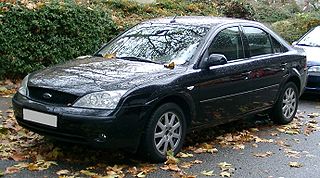
The Ford Mondeo Mk3 (second generation) model was launched by Ford in October 2000. This Mondeo was considerably larger than its predecessor, and although Ford abandoned its New Edge design theme for the second generation, it was their first vehicle to fully benefit from the Prodigy concept car. This gave it an overall effect which many critics felt was more restrained and mature, if much less distinctive. Two of the old car's biggest weaknesses, the modest rear legroom, and uncompetitive diesel version were addressed by a 50 mm (2.0 in) longer wheelbase and the new Duratorq diesel engine. The basic chassis and suspension design was carried over from the previous generation, which meant that the car continued its predecessor's reputation for class leading handling and ride. This Mondeo came to Mexico, replacing the North American built Ford Contour, and was sold from 2001 to 2007, when the Ford Fusion replaced it. The North American market Fusion and Ford Five Hundred/Taurus sported very similar styling, inside and out.

The Fiesta Mark IV was launched in October 1995 and became Britain's best-selling car from 1996 to 1998, when it was overtaken by the all-new Ford Focus, a replacement for the Ford Escort.

The Ford Fiesta Mk5 is the fifth generation of the Ford Fiesta supermini built in Europe between April 2002 and 2008. The Fiesta continued to be built in Mexico until 2010 and in Brazil until 2014. Most engines were carried over from the previous Fiesta. This generation became the best-selling Ford Fiesta generation to date. This was the first Fiesta to be sold in Asia and Australasia, where it replaced the Kia-based Festiva.



